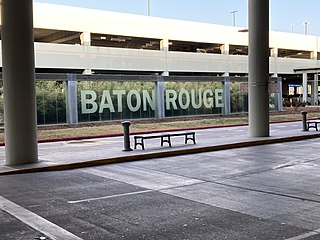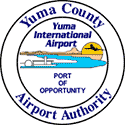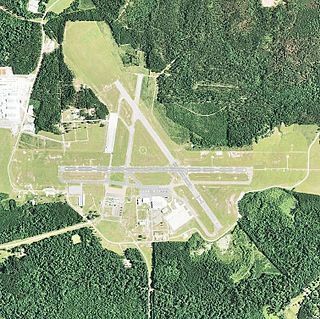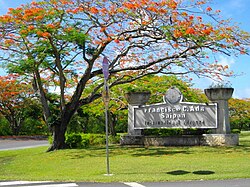
Continental Micronesia, Inc. (CMI) was a Guamanian company which was a wholly owned subsidiary of Continental Airlines. It operated daily flights to Honolulu, Hawaii, as well as international services to Asia, Micronesia and Australia from its base of operations at Antonio B. Won Pat International Airport on Guam, a U.S. territory in the western Pacific Ocean. During its final years, the airline, a Delaware corporation, was headquartered in the old terminal building at Won Pat International Airport in Tamuning, Guam.

Antonio B. Won Pat International Airport, also known as Guam International Airport, is an airport located in Tamuning and Barrigada, three miles (4.8 km) east of the capital city of Hagåtña in the United States territory of Guam. The airport is a hub for Asia Pacific Airlines and for United Airlines, serving as the latter's Pacific Ocean hub. It is also the home of the former Naval Air Station Agana, and is the only international airport in the territory. The airport is named after Antonio Borja Won Pat, the first delegate from Guam to the United States House of Representatives, and is operated by the A.B. Won Pat International Airport Authority, Guam, an agency of the Government of Guam.

Lubbock Preston Smith International Airport is five miles north of Lubbock, in Lubbock County, Texas, United States. Originally Lubbock International Airport, it was renamed in 2004 for former Texas governor Preston E. Smith, an alumnus of Texas Tech University.

Baton Rouge Metropolitan Airport, also known as Ryan Field, is a public use airport located four miles (7 km) north of the central business district of Baton Rouge, a city in East Baton Rouge Parish, Louisiana, United States.

Yuma International Airport is a joint use airport with civilian and military flight activity operated in conjunction with the U.S. Marine Corps via the Marine Corps Air Station Yuma. The airfield is located 3.5 miles south of the central business district of Yuma, a city in Yuma County, Arizona, United States, and 150 miles east of San Diego International Airport. It is mostly used for military aviation, but is also served by one commercial airline and one aeromedical Medevac company as well as being used for general aviation activities.

Juneau International Airport is a city-owned, public-use airport and seaplane base located seven nautical miles northwest of the central business district of Juneau, a city and borough in the U.S. state of Alaska that has no direct road access to the outside world. The airport serves as a regional hub for all air travel, from bush carriers to major U.S. air carriers such as Alaska Airlines.

Kinston Regional Jetport, also known as Stallings Field, is a public airport located three miles (5 km) northwest of the central business district of Kinston, a city in Lenoir County, North Carolina. The airport has a single runway that is one of the longest in the southeastern United States. It is mostly used for general aviation.

Pinal Airpark, also known as Pinal County Airpark, is a non-towered, county-owned, public-use airport located 8 miles northwest of the central business district of Marana, in Pinal County, Arizona, United States. Silverbell Army Heliport is co-located with Pinal Airpark. The heliport is a private-use military facility operated by the Arizona Army National Guard.

Tinian International Airport, also known as West Tinian Airport, is a public airport located on Tinian Island in the United States Commonwealth of the Northern Mariana Islands. This airport is owned by Commonwealth Ports Authority.
Rota International Airport, also known as Benjamin Taisacan Manglona International Airport, is a public airport located on Rota Island in the United States Commonwealth of the Northern Mariana Islands (CNMI), near the village of Sinapalo. The airport is owned by the Commonwealth Ports Authority. During WWII the Japanese constructed a single runway which the U.S. bombed out of commission. After the Marines took control of the island 300 men from the 48th U.S.Naval Construction Battalion made the airfield operational during Sept-Oct 1945 and extended to 5,000 feet (1,500 m). The runway was then used as an emergency landing strip for Tinian and Saipan airfields. In modern times it used for short commuter flights to nearby Marianas Islands.

Bucholz Army Airfield is a United States Army airfield located on Kwajalein Atoll, Marshall Islands. Its position is ideal for refueling during trans-Pacific flights, and the airport is available to civilians through Air Marshall Islands and United Airlines.

Chuuk International Airport is an airport located on Weno, the main island of the State of Chuuk in the Federated States of Micronesia.

Naval Air Station Agana is a former United States Naval air station located on the island of Guam. It was opened by the Japanese Navy in 1943 and closed by the United States government in 1995. During and after its closure, it was operated alongside Antonio B. Won Pat International Airport.

Landing Beaches; Aslito/Isely Field & Marpi Point, Saipan Island is a National Historic Landmark District consists of several discontiguous areas of the island of Saipan in the Northern Mariana Islands. The sites were designated for their association with the Japanese defense of Saipan during World War II, the 1944 Battle of Saipan in which United States forces captured the island, and the subsequent campaigns which used Saipan as a base. The district includes the landing beaches where the U.S. forces landed, the remnants of Japanese airfields Aslito and Marpi Point and Isely Field, the airfield built over much of Aslito from which B-29 bombers were used to bomb the Japanese home islands. The Marpi Point area includes Suicide Cliff and Banzai Cliff, two locations where significant numbers of Japanese military and civilians jumped to their deaths rather than surrender to advancing U.S. forces. The loss of Saipan was a major blow to the Japanese war effort, leading to the resignation of Prime Minister Hideki Tojo, The landmark designation was made in 1985.

Esler Field, also known as Esler Regional Airport, is a military and public use airfield in Rapides Parish, Louisiana, United States, near the City of Pineville. It is located 10 nautical miles northeast of the central business district of Alexandria, Louisiana, The airfield is owned by the Louisiana Army National Guard and is the home of Army Aviation Support Facility #2 (AASF#2).

Fletcher Field is a public use airport in Coahoma County, Mississippi, United States. It is owned by the Coahoma County Airport Board and located seven nautical miles (13 km) northeast of the central business district of Clarksdale, Mississippi. This airport is included in the National Plan of Integrated Airport Systems for 2011–2015, which categorized it as a general aviation facility. There is no scheduled commercial airline service.

Kobler Field is a former a World War II airfield on Saipan in the Mariana Islands, part of Naval Advance Base Saipan. It was closed in 1977 and redeveloped as a residential housing area.

Marpi Point Field or NAB Marpi Point is a former World War II airfield at the northern end of Saipan in the Northern Mariana Islands. The airfield was vacated by the United States in 1962; it is currently unused and overgrown.

Star Marianas Air, Inc. is a U.S. commuter airline headquartered at Tinian International Airport in Tinian Municipality, Northern Mariana Islands. It operates scheduled and charter passenger service in the Commonwealth of the Northern Mariana Islands and Guam, both U.S. territories in the Pacific Ocean.

Naval Base Saipan or Naval Advance Base Saipan or Naval Air Base Saipan was a United States Navy Naval base built during World War II to support Pacific Ocean theater of war and the many warships and troops fighting the war. The base was on the island of Saipan in the Northern Mariana Islands. The base was part of the Pacific island hopping campaign. The base construction started after the Battle of Saipan ended on July 9, 1944. US Naval Advance Base Saipan was constructed by the Seabees Naval Mobile Construction Battalions. The base was under the Commander Naval Forces Marianas. Saipan is 12 miles (19 km) long and 5 miles (8.0 km) wide. About 70% of the island was sugarcane cultivation at the start of the base construction. At the start of the Battle of Saipan, the island's population had about 30,000 Japanese troops and about 20,000 Japanese civilians. The city of Garapan was the administrative center for the Saipan governmental district.


























